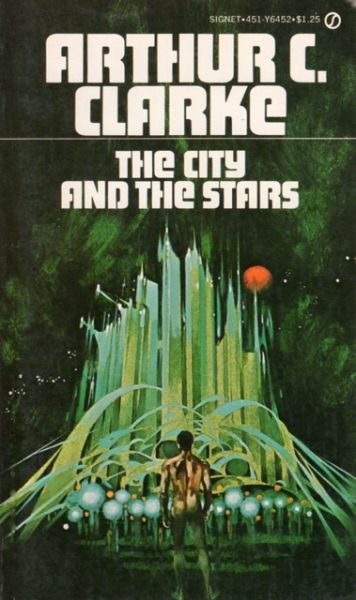We’re Better Off Apart
The City and the Stars
By Arthur C. Clarke

29 Sep, 2019
Arthur C. Clarke’s 1956 The City and the Stars is a standalone SF novel. A famous SF novel.
A billion years in the future, Earth is a lifeless, arid desert world. The galaxy-spanning civilization of the ancients is gone, the victim, or so myth has it, of nigh-unstoppable Invaders. The last remnant of humanity lives in the city of Diaspar. The inhabitants are effectively immortal, being reincarnated over and over again from Central Computer records.
Once reborn, they take up their old roles. That is, everyone but young Alvin, one of the rare unique persons intermittently created to ensure that Diaspar does not completely stagnate. Alvin is going to succeed in this purpose and then some.
Alvin’s questing nature often brings him into conflict with his fellow immortals, who have no interest in innovation or change. He begins to wonder if he could find something different if he were to leave the city. But leaving is forbidden. Not only that, it seems impossible. The towering walls of the city look upon endless sands. There’s no road, no destination.
Alvin is befriended by Khedron the Jester, another designated disruptive element. He’s the city’s trickster. With Khedon’s help, Alvin learns that in the ancient past, the cities of the world were linked by an advanced subterranean transportation system. The other cities may be long gone but the underground system survives. Humanity built well.
Alvin embarks on an underground train and learns that much of what he has been told is not true. Diaspar is not the only human city remaining on the planet. Lys also survives.
Diaspar prizes technology and immortality; the inhabitants of bucolic Lys prefer a rustic, limited existence. No eternal life for them. As if to compensate, the people of Lys do have telepathic gifts unknown in Diaspar.
For a time, Alvin revels in a new life in exotic Lys. But only for a time. Alvin is restless by nature. Just as he tired of Diaspar’s limits, so too does he tire of Lys. He can leave if he wishes, the Lysians tell him, but if he does, they will erase his memories of Lys. They have no interest in being discovered by Diaspar.
Alvin cannot decide what to do. He delays. He and his Lysian friend Hilvar head out on an expedition to a remote corner of Lys, where they discover an ancient relic that will yet again rewrite Alvin’s knowledge of human history and lead to real change on the not-yet-dead planet Earth.
~oOo~
The City and the Stars is a revised, expanded, version of the 1953 Against the Fall of Night. That said, modern readers may find it surprisingly compact. My Signet edition is under two hundred pages.
Readers expecting daring life and death crises should look elsewhere. The era of grand, existential crises was a billion years in the past. Alvin, Hilvar, and readers learn about them long after there was any chance that they might affect history. The plot, such as it is, is driven by curiosity and rediscovery.
The two human communities have made very different choices but have still ended up in similar dead ends. It’s probably no coincidence that Diaspar sounds like Despair, and Lys sounds like Lies. The grand events of a billion years ago traumatized humanity. Both cities have turned their backs on the outside world1. Both are decent tries at utopia; decent in that neither community depends on has a small child being tortured in a some dark basement, that no one is hungry or oppressed by anything other than boredom. If both are ultimately unsatisfactory, that’s the nature of utopias.
Like the plot, the prose and characterization are sufficient for the book’s needs but no more. Really, if you’re looking for writing better than workmanlike, 1950s SF probably isn’t the place to look. The book has other virtues, though, enough to warrant a read.
The City and the Stars is available here (Amazon), here (Amazon.ca), and here (Chapters-Indigo).
1: Lys has spent a billion years hiding from Diaspar, unaware that Diaspar has spent a billion years refusing to learn anything about the outside world.
